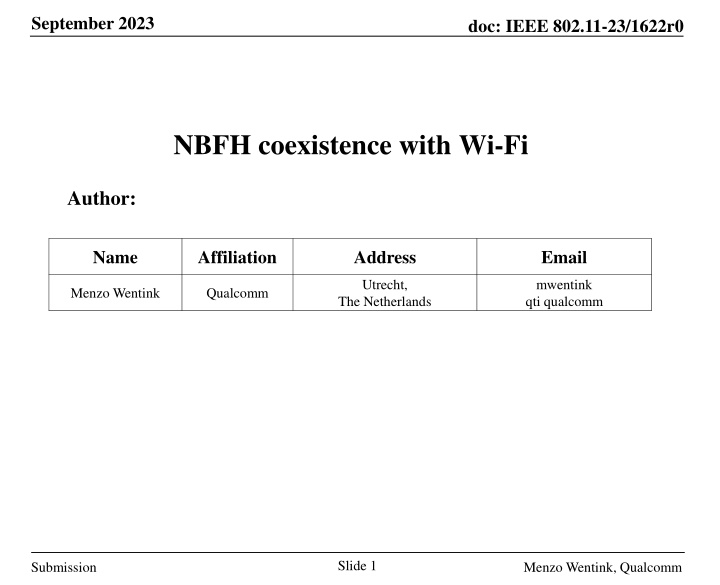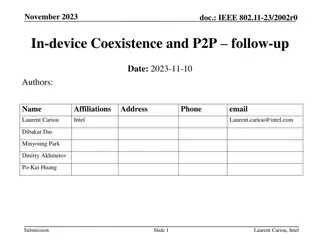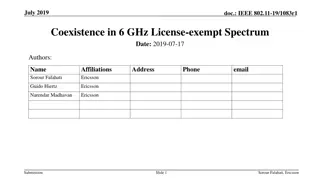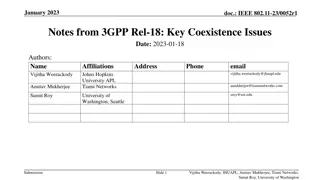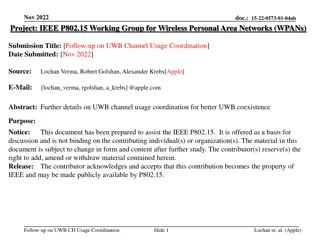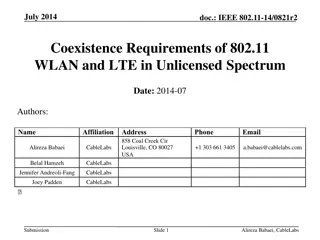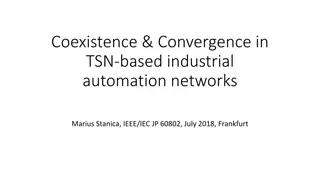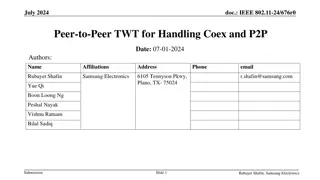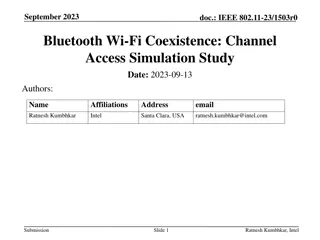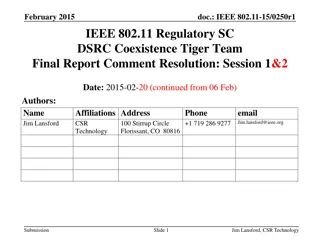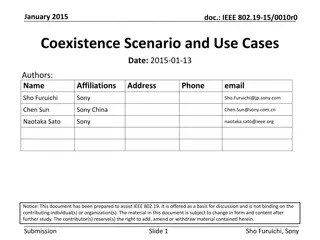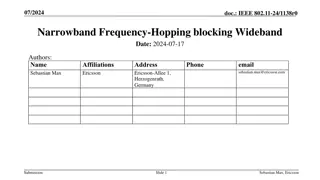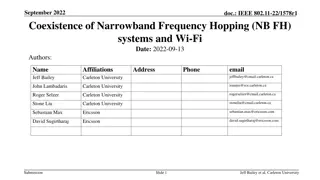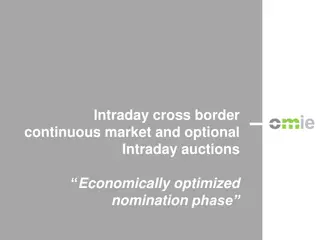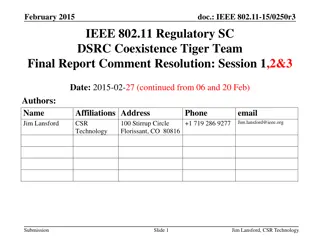NBFH Coexistence with Wi-Fi in September 2023
This document delves into the impact and simulation parameters of Narrowband Frequency Hopping (NBFH) on Wi-Fi networks. It explores the coexistence challenges and solutions presented by NBFH technology in the context of IEEE 802.11 standards. The author, Menzo Wentink from Qualcomm, provides detailed insights into NBFH's effects on Wi-Fi broadcast, topology, and beacon reception. The simulations cover transmission powers, dwell times, hopping patterns, and channel models to analyze the performance under various scenarios. The implications of NBFH on isochronous audio transmission and duty cycles are also discussed.
Download Presentation

Please find below an Image/Link to download the presentation.
The content on the website is provided AS IS for your information and personal use only. It may not be sold, licensed, or shared on other websites without obtaining consent from the author.If you encounter any issues during the download, it is possible that the publisher has removed the file from their server.
You are allowed to download the files provided on this website for personal or commercial use, subject to the condition that they are used lawfully. All files are the property of their respective owners.
The content on the website is provided AS IS for your information and personal use only. It may not be sold, licensed, or shared on other websites without obtaining consent from the author.
E N D
Presentation Transcript
September 2023 doc: IEEE 802.11-23/1622r0 NBFH coexistence with Wi-Fi Author: Name Affiliation Address Email Utrecht, mwentink qti qualcomm Menzo Wentink Qualcomm The Netherlands Slide 1 Submission Menzo Wentink, Qualcomm
September 2023 doc: IEEE 802.11-23/1622r0 Impact of NBFH on Wi-Fi Broadcast Slide 2 Submission Menzo Wentink, Qualcomm
September 2023 doc: IEEE 802.11-23/1622r0 Wi-Fi / NBFH simulation parameters Beacon Rx Wi-Fi settings Tx power: 23 dBm at AP (LPI), 21 dBm at STA (LPI) packet type: Beacons only (300 us, 20 MHz) beacon period: 100 ms (10 beacons/s) PHY rate: 6 Mbps OFDM NBFH settings Tx power: 14 dBm (VLP) dwell time: 463 us 150 us IFS, 313 us Tx, 68% duty cycle per link 300 us IFS, 163 us Tx, 35% duty cycle per link hop width: 2 MHz (15 Mbps max PHY rate, Nss = 1) hopping pattern: random, 10 to 160 hops in 20 to 320 MHz, respectively eDAA settings: 0.125 s between CCA evaluations, 1.25 s before possible release (eDAA 125) CCA trigger settings: 7 us CCA before each hop, FBE, trigger thresholds 3+3/24, 20 MHz segments the values 3+3/24 indicate a threshold of 3, then a bump of 3 (to 6) for extra hysteresis, and 24 is the max value staggered startup during first 0.5 s bi-directional traffic with two peripherals isochronous audio, 1, 2 or 4 CIG events (tries) per ISO cycle (CIG 1, CIG 2, CIG 4) Channel model AWGN channel with a breakpoint at 5 m pathloss = 40.05 + 20log10(f/2.4) + 20log10(min(d, b)) + (d > b) * (35log10(d/b)) where f = 5.18 GHz, d = distance, b = breakpoint = 5 m Slide 3 Submission Menzo Wentink, Qualcomm
September 2023 doc: IEEE 802.11-23/1622r0 BT isochronous audio illustration CIG 1 1 try (0 retries), 17% duty cycle CIG 2 2 tries (1 retry), 34% duty cycle CIG 4 4 tries (3 retries), 68% duty cycle Slide 4 Submission Menzo Wentink, Qualcomm
September 2023 doc: IEEE 802.11-23/1622r0 Wi-Fi / NBFH topology Beacon Rx AP LPI Wi-Fi link downlink traffic VLP NBFH links VLP NBFH links STA nb_broadcast_edaa_r2102a-e nb_broadcast_lbt_r2102a-e Slide 5 Submission Menzo Wentink, Qualcomm
September 2023 doc: IEEE 802.11-23/1622r0 Impact on Beacon Rx (CIG 1) eDAA 125 Wi-Fi: 0.45% dc, Beacons NB: 17% dc per link CIG 1 nb_broadcast_edaa_r2303a-e nb_broadcast_lbt_r2303a-e Slide 6 Submission Menzo Wentink, Qualcomm
September 2023 doc: IEEE 802.11-23/1622r0 Impact on Beacon Rx (CIG 2) eDAA 125 Wi-Fi: 0.45% dc, Beacons NB: 34% dc per link CIG 2 nb_broadcast_edaa_r2303a-e nb_broadcast_lbt_r2303a-e Slide 7 Submission Menzo Wentink, Qualcomm
September 2023 doc: IEEE 802.11-23/1622r0 Impact on Beacon Rx (CIG 4) eDAA 125 Wi-Fi: 0.3% dc, Beacons NB: 68% dc per link CIG 4 nb_broadcast_edaa_r2102a-e nb_broadcast_lbt_r2102a-e Slide 8 Submission Menzo Wentink, Qualcomm
September 2023 doc: IEEE 802.11-23/1622r0 Observations Beacon Rx NB with eDAA can cause significant degradation in Wi-Fi broadcast packet receptions NB with LBT sees no degradation Broadcast is important for Wi-Fi operation, for several reasons: network discovery and management beacons, probe request, fast discovery (FILS), TIM power save, TIM broadcast, etc. service discovery ARP, Bonjour, Apple Airplay, Google Chromecast, mDNS, Wi-Fi direct, ANQP, etc. channel evacuation for radar detection (DFS) channel switch request (CSR) interfering with DFS signaling might have regulatory implications as well broadcast services 802.11bc (EBCS), TV broadcast, radio broadcast, etc. see also the EBCS slides further in this slide deck Without reliable broadcast, Wi-Fi will not work well Slide 9 Submission Menzo Wentink, Qualcomm
September 2023 doc: IEEE 802.11-23/1622r0 Enhanced Broadcast Services (EBCS) EBCS is standardized in 802.11bc Slide 10 Submission Menzo Wentink, Qualcomm
September 2023 doc: IEEE 802.11-23/1622r0 Wi-Fi / NBFH simulation parameters EBCS Wi-Fi settings Tx power: 23 dBm at AP (LPI), 21 dBm at STA (LPI) packet size: 5 ms downlink traffic, EBCS channel width: 160 MHz max bitrate: 2402 Mbps at HE MCS 11, 160 MHz, 2x996-tone RU, Nss = 2, 800 ns GI frame exchange: Broadcast Data (EBCS) start time: 0 s 20 pps (50 ms between packets), 4% on air duty cycle NBFH settings (BT) Tx power: 14 dBm (VLP) dwell time: 625 us hop width: 4 MHz hopping width: 500 MHz (random hopping pattern, 125 hops) eDAA settings: 0.5 s between CCAs, evacuation in 20 MHz blocks, two options for channel restoration: option 1: after 0.5 s when CCA is clear option 2: after 2.5 s without CCA (exponentially increasing) start time: 5 s downlink traffic, full buffer Channel model AWGN channel with a breakpoint at 5 m pathloss = 40.05 + 20log10(f/2.4) + 20log10(min(d, b)) + (d > b) * (35log10(d/b)) where f = 5.18 GHz, d = distance, b = breakpoint = 5 m Slide 11 Submission Menzo Wentink, Qualcomm
September 2023 doc: IEEE 802.11-23/1622r0 Broadcast traffic 802.11bc Enhanced Broadcast Services (EBCS) 15 AP 10 LPI Wi-Fi link downlink traffic Broadcast traffic (EBCS) y (m) 5 (20 pps, 50 ms between packets, 4% on air duty cycle) 0 VLP NB link STA 4 MHz hop width 500 MHz hopping width -5 -8 -6 -4 -2 0 2 4 6 8 10 x (m) nb_r400b Slide 12 Submission Menzo Wentink, Qualcomm
September 2023 doc: IEEE 802.11-23/1622r0 Wi-Fi/NB eDAA with Option 1 EBCS eDAA fails to reliably detect the low duty cycle Wi-Fi broadcast transmissions and NB causes major interference to Wi-Fi NB starts at 5 s eDAA detection of the periodic Wi-Fi broadcast traffic is very unreliable The NB latency is considerable, especially for the low Wi-Fi duty cycle of 4%, because eDAA disables 20 MHz segments for a significant amount of time nb_r414 Slide 13 Submission Menzo Wentink, Qualcomm
September 2023 doc: IEEE 802.11-23/1622r0 Wi-Fi/NB eDAA with Option 2 EBCS eDAA fails to reliably detect the low duty cycle Wi-Fi broadcast transmissions and NB causes major interference to Wi-Fi NB starts at 5 s eDAA detection of the periodic Wi-Fi broadcast traffic is very unreliable The NB latency is considerable, especially for the low Wi-Fi duty cycle of 4%, because eDAA disables 20 MHz segments for a significant amount of time nb_r400b Slide 14 Submission Menzo Wentink, Qualcomm
September 2023 doc: IEEE 802.11-23/1622r0 Wi-Fi/NB LBT EBCS Throughput per node (Mbps) Aggregate throughput (Mbps) 150 150 Aggregate throughput(Mbps) NB with LBT defers for ongoing Wi-Fi broadcast transmissions Throughput (Mbps) 100 100 50 50 The NB throughput is essentially unaffected 0 0 0 5 10 15 20 0 5 10 15 20 Time (s) Time (s) NB starts at 5 s Number of Active Hops Access delay (ms) 25 120 Number of Active Hops 20 Access delay (ms) 100 15 80 60 10 40 5 The NB latency is low when it uses LBT 20 (This plot is not defined for LBT) 0 0 0 5 10 15 20 0 5 10 15 20 Time (s) Time (s) nb_r400b Slide 15 Submission Menzo Wentink, Qualcomm
September 2023 doc: IEEE 802.11-23/1622r0 eDAA dynamic behavior Slide 16 Submission Menzo Wentink, Qualcomm
September 2023 doc: IEEE 802.11-23/1622r0 eDAA 125 There has been a proposal for a further enhanced eDAA eDAA 125 0.125 s between CCA evaluations (instead of 0.5 s) channel restoration after 1.25 s when the CCA is clear (instead of 0.5 s) evacuation in 20 MHz blocks (same as original eDAA) Slide 17 Submission Menzo Wentink, Qualcomm
September 2023 doc: IEEE 802.11-23/1622r0 1 CIG event per ISO interval Slide 18 Submission Menzo Wentink, Qualcomm
September 2023 doc: IEEE 802.11-23/1622r0 Wi-Fi / NBFH simulation parameters 60% Wi-Fi dc, CIG 1 Wi-Fi settings Tx power: 23 dBm at AP (LPI), 21 dBm at STA (LPI) packet size: 5 ms downlink traffic, 60% duty cycle 5 ms TXOP every 8.3 ms channel width: 80 MHz max bitrate: 1201 Mbps at HE MCS 11, 80 MHz, 996-tone RU, Nss = 2, 800 ns GI genie throughput frame exchange: RTS/CTS/A-MPDU/BA start time: 3 s NBFH settings (BT) Tx power: 14 dBm (VLP) dwell time: 463 us 313 us Tx, 150 us IFS, 68% duty cycle per link 163 us Tx, 300 us IFS, 35% duty cycle per link hop width: 2 MHz (15 Mbps max PHY rate, Nss = 1) hopping pattern: random, 80 hops (160 MHz total) eDAA settings: 0.125 s between CCA evaluations, 1.25 s before possible release (eDAA 125) CCA trigger settings: 7 us CCA before each hop, FBE, trigger threshold 3+3/24, 20 MHz segments the values 3+3/24 indicate a threshold of 3, then a bump of 3 (to 6) for extra hysteresis, and 24 is the max value startup staggered during first 0.5 s bi-directional traffic with two peripherals Channel model AWGN channel with a breakpoint at 5 m pathloss = 40.05 + 20log10(f/2.4) + 20log10(min(d, b)) + (d > b) * (35log10(d/b)) where f = 5.18 GHz, d = distance, b = breakpoint = 5 m Slide 19 Submission Menzo Wentink, Qualcomm
September 2023 doc: IEEE 802.11-23/1622r0 Wi-Fi / NBFH topology 60% Wi-Fi dc, CIG 1 Wi-Fi: 80 MHz 60% duty cycle AP BT: 160 MHz 1 BT central, 2 peripherals per link VLP NBFH links VLP NBFH links STA LPI Wi-Fi link downlink traffic nb_r2202a Slide 20 Submission Menzo Wentink, Qualcomm
September 2023 doc: IEEE 802.11-23/1622r0 Wi-Fi / NBFH (LBT with CCA trigger) 60% Wi-Fi dc, CIG 1 trigger 3+3/24 60% dc on Wi-Fi link 68% dc per NB link A more optimal approach is probably to have longer term (AFH-style) evacuation, in combination with a return based on an offline scan (like eDAA) and possibly some number of consecutive idle CCAs nb_r2202c Slide 21 Submission Menzo Wentink, Qualcomm
September 2023 doc: IEEE 802.11-23/1622r0 Wi-Fi / NBFH (eDAA 125) 60% Wi-Fi dc, CIG 1 eDAA 125 60% dc on Wi-Fi link 68% dc per NB link 260 ms long tail nb_r2202d Slide 22 Submission Menzo Wentink, Qualcomm
September 2023 doc: IEEE 802.11-23/1622r0 2 CIG events per ISO interval Slide 23 Submission Menzo Wentink, Qualcomm
September 2023 doc: IEEE 802.11-23/1622r0 Wi-Fi / NBFH simulation parameters 60% Wi-Fi dc, CIG 2 Wi-Fi settings Tx power: 23 dBm at AP (LPI), 21 dBm at STA (LPI) packet size: 5 ms downlink traffic, 60% duty cycle 5 ms TXOP every 8.3 ms channel width: 80 MHz max bitrate: 1201 Mbps at HE MCS 11, 80 MHz, 996-tone RU, Nss = 2, 800 ns GI genie throughput frame exchange: RTS/CTS/A-MPDU/BA start time: 3 s NBFH settings (BT) Tx power: 14 dBm (VLP) dwell time: 463 us 313 us Tx, 150 us IFS, 68% duty cycle per link 163 us Tx, 300 us IFS, 35% duty cycle per link hop width: 2 MHz (15 Mbps max PHY rate, Nss = 1) hopping pattern: random, 80 hops (160 MHz total) eDAA settings: 0.125 s between CCA evaluations, 1.25 s before possible release (eDAA 125) CCA trigger settings: 7 us CCA before each hop, FBE, trigger threshold 3+3/24, 20 MHz segments the values 3+3/24 indicate a threshold of 3, then a bump of 3 (to 6) for extra hysteresis, and 24 is the max value startup staggered during first 0.5 s bi-directional traffic with two peripherals Channel model AWGN channel with a breakpoint at 5 m pathloss = 40.05 + 20log10(f/2.4) + 20log10(min(d, b)) + (d > b) * (35log10(d/b)) where f = 5.18 GHz, d = distance, b = breakpoint = 5 m Slide 24 Submission Menzo Wentink, Qualcomm
September 2023 doc: IEEE 802.11-23/1622r0 Wi-Fi / NBFH topology 60% Wi-Fi dc, CIG 2 Wi-Fi: 80 MHz 60% duty cycle AP BT: 160 MHz 1 BT central, 2 peripherals per link VLP NBFH links VLP NBFH links STA LPI Wi-Fi link downlink traffic nb_r2202a Slide 25 Submission Menzo Wentink, Qualcomm
September 2023 doc: IEEE 802.11-23/1622r0 Wi-Fi / NBFH (LBT with CCA trigger) 60% Wi-Fi dc, CIG 2 trigger 3+3/24 60% dc on Wi-Fi link 68% dc per NB link A more optimal approach is probably to have longer term (AFH-style) evacuation, in combination with a return after some number of consecutive idle CCAs nb_r2202a Slide 26 Submission Menzo Wentink, Qualcomm
September 2023 doc: IEEE 802.11-23/1622r0 Wi-Fi / NBFH (eDAA 125) 60% Wi-Fi dc, CIG 2 eDAA 125 60% dc on Wi-Fi link 68% dc per NB link 520 ms long tail nb_r2202b Slide 27 Submission Menzo Wentink, Qualcomm
September 2023 doc: IEEE 802.11-23/1622r0 4 CIG events per ISO interval Slide 28 Submission Menzo Wentink, Qualcomm
September 2023 doc: IEEE 802.11-23/1622r0 Wi-Fi / NBFH simulation parameters 60% Wi-Fi dc, CIG 4 Wi-Fi settings Tx power: 23 dBm at AP (LPI), 21 dBm at STA (LPI) packet size: 5 ms downlink traffic, 60% duty cycle 5 ms TXOP every 8.3 ms channel width: 80 MHz max bitrate: 1201 Mbps at HE MCS 11, 80 MHz, 996-tone RU, Nss = 2, 800 ns GI genie throughput frame exchange: RTS/CTS/A-MPDU/BA start time: 3 s NBFH settings (BT) Tx power: 14 dBm (VLP) dwell time: 463 us 313 us Tx, 150 us IFS, 68% duty cycle per link 163 us Tx, 300 us IFS, 35% duty cycle per link hop width: 2 MHz (15 Mbps max PHY rate, Nss = 1) hopping pattern: random, 80 hops (160 MHz total) eDAA settings: 0.125 s between CCA evaluations, 1.25 s before possible release (eDAA 125) CCA trigger settings: 7 us CCA before each hop, FBE, trigger threshold 3+3/24, 20 MHz segments the values 3+3/24 indicate a threshold of 3, then a bump of 3 (to 6) for extra hysteresis, and 24 is the max value startup staggered during first 0.5 s bi-directional traffic with two peripherals Channel model AWGN channel with a breakpoint at 5 m pathloss = 40.05 + 20log10(f/2.4) + 20log10(min(d, b)) + (d > b) * (35log10(d/b)) where f = 5.18 GHz, d = distance, b = breakpoint = 5 m Slide 29 Submission Menzo Wentink, Qualcomm
September 2023 doc: IEEE 802.11-23/1622r0 Wi-Fi / NBFH topology 60% Wi-Fi dc, CIG 4 Wi-Fi: 80 MHz 60% duty cycle AP BT: 160 MHz 1 BT central, 2 peripherals per link VLP NBFH links VLP NBFH links STA LPI Wi-Fi link downlink traffic nb_r2201c Slide 30 Submission Menzo Wentink, Qualcomm
September 2023 doc: IEEE 802.11-23/1622r0 Wi-Fi / NBFH (LBT with CCA trigger) 60% Wi-Fi dc, CIG 4 trigger 3+3/24 60% dc on Wi-Fi link 68% dc per NB link A more optimal approach is probably to have longer term (AFH-style) evacuation, in combination with a return after some number of consecutive idle CCAs nb_r2201c Slide 31 Submission Menzo Wentink, Qualcomm
September 2023 doc: IEEE 802.11-23/1622r0 Wi-Fi / NBFH (eDAA 125) 60% Wi-Fi dc, CIG 4 eDAA 125 60% dc on Wi-Fi link 68% dc per NB link 210 ms long tail nb_r2201d Slide 32 Submission Menzo Wentink, Qualcomm
September 2023 doc: IEEE 802.11-23/1622r0 on/off traffic Slide 33 Submission Menzo Wentink, Qualcomm
September 2023 doc: IEEE 802.11-23/1622r0 Wi-Fi / NBFH simulation parameters on/off traffic Wi-Fi settings Tx power: 23 dBm at AP (LPI), 21 dBm at STA (LPI) packet size: 5 ms downlink traffic, full buffer on/off on/off traffic, 0.3 s on, 2 s off (15% duty cycle) like bursts of 4k Netflix streaming data in a Target Wake Time (TWT) setting at Wi-Fi channel width: 80 MHz max bitrate: 1201 Mbps at HE MCS 11, 80 MHz, 996-tone RU, Nss = 2, 800 ns GI genie throughput frame exchange: RTS/CTS/A-MPDU/BA start time: 3 s NBFH settings (BT) Tx power: 14 dBm (VLP) dwell time: 463 us 313 us Tx, 150 us IFS, 68% duty cycle per link 163 us Tx, 300 us IFS, 35% duty cycle per link 453 us Tx, 10 us IFS, 98% duty cycle per link hop width: 2 MHz (15 Mbps max PHY rate, Nss = 1, scaled Wi-Fi MCS) hopping pattern: random, 80 hops (160 MHz total) eDAA settings: 0.125 s between CCA evaluations, 1.25 s before possible release (eDAA 125) CCA trigger settings: 7 us CCA before each hop, FBE, trigger thresholds 3+3/24, 20 MHz segments 3+3/24 indicates a threshold of 3, then a bump of 3 (to 6) for extra hysteresis, and 24 is the max value startup staggered during first 0.5 s bi-directional traffic with two peripherals Channel model AWGN channel with a breakpoint at 5 m pathloss = 40.05 + 20log10(f/2.4) + 20log10(min(d, b)) + (d > b) * (35log10(d/b)) where f = 5.18 GHz, d = distance, b = breakpoint = 5 m Slide 34 Submission Menzo Wentink, Qualcomm
September 2023 doc: IEEE 802.11-23/1622r0 Wi-Fi / NBFH topology on/off traffic Wi-Fi: 80 MHz on/off traffic AP BT: 160 MHz 1 BT central, 2 peripherals per link VLP NBFH links VLP NBFH links STA LPI Wi-Fi link downlink traffic nb_r2101a Slide 35 Submission Menzo Wentink, Qualcomm
September 2023 doc: IEEE 802.11-23/1622r0 Wi-Fi / NBFH (LBT with CCA trigger) on/off traffic trigger 3+3/12 on/off traffic 68% dc per NB link CIG 4 nb_r2101a Slide 36 Submission Menzo Wentink, Qualcomm
September 2023 doc: IEEE 802.11-23/1622r0 Wi-Fi / NBFH (eDAA 125 with LBT) on/off traffic eDAA 125 on/off traffic 68% dc per NB link CIG 4 eDAA 125 does respond, but too late and in xome cases not at all nb_r2101b Slide 37 Submission Menzo Wentink, Qualcomm
September 2023 doc: IEEE 802.11-23/1622r0 Wi-Fi / NBFH (LBT with CCA trigger) on/off traffic trigger 3+3/24 on/off traffic 98% dc per NB link CIG 4 nb_r2101c Slide 38 Submission Menzo Wentink, Qualcomm
September 2023 doc: IEEE 802.11-23/1622r0 Wi-Fi / NBFH (eDAA 125 with LBT) on/off traffic eDAA 125 on/off traffic 98% dc per NB link CIG 4 eDAA 125 does respond, but too late and in some cases not at all nb_r2101d Slide 39 Submission Menzo Wentink, Qualcomm
September 2023 doc: IEEE 802.11-23/1622r0 Observations eDAA 125 eDAA 125 eDAA 125 is an improvement over the initial eDAA, but probably not sufficient the response time still appears to be too slow ongoing Wi-Fi transmissions are not protected because there is no LBT CCA trigger the trigger threshold is not related to 60% medium utilization, but to discerning NB from WB (through the consecutive aspect in the trigger) a trigger threshold of 3 is preferred over 6 some more background is in section NB/NB collision probability in this slide deck CCA trigger can be improved by increasing the upper limit to 24 and adding some extra hysteresis (+3 once 3 is reached) CCA trigger could be further improved by including the CCA result also before an Rx slot a busy CCA would of course not preempt the reception (as it would for a transmission), but it would tie into CCA trigger for a faster response in the presence of Wi-Fi not simulated yet once the trigger threshold has been reached (or some secondary threshold a little higher), evacuation can be the same as eDAA, including AFH returning to the channel could also be similar to eDAA (e.g. based on an offline spectrum scan), when several consecutive LBT CCAs are idle i.e. there is no need for continuous CCA checks on evacuated channels a longer absence time will also improve coexistence Slide 40 Submission Menzo Wentink, Qualcomm
September 2023 doc: IEEE 802.11-23/1622r0 Appendix Overview of NB channel access mechanisms Slide 41 Submission Menzo Wentink, Qualcomm
September 2023 doc: IEEE 802.11-23/1622r0 LBT for NB Listen before Talk (LBT) for NB uses a CCA before every hop fixed LBT before every scheduled transmission could also be referred to as Frame Based LBT (FB-LBT) With some extra measures, the CCA time could be relatively short details are in the next slide on LBT with CCA trigger without extra measures, the CCA time should be in the order of 187 us, so that access will not happen during Wi-Fi backoffs and SIFS intervals the potentially high frequency of the NB CCAs makes it necessary that the CCA time is not too short but a long CCA time is difficult to integrate into the existing NB architecture Slide 42 Submission Menzo Wentink, Qualcomm
September 2023 doc: IEEE 802.11-23/1622r0 LBT with CCA trigger CCA trigger is an LBT-based access mechanism that uses a short CCA (e.g. 7 us) before every hop, but disables a 20 MHz segment when multiple consecutive CCA-busies ('triggers') occur in the segment, until several consecutive CCA-idles occur in the segment the NB node keeps a tally of consecutive CCA busy events ('triggers') in each segment that it hops in: +1 when the CCA before a hop inside the segment is busy 1 when the CCA before a hop inside the segment is idle when the number of triggers 3 the segment is blocked, otherwise it can be used (provided that the CCA before hops in that segment is idle) the trigger count is capped between 0 and 6, which implies a hysteresis of 4 consecutive CCA idles before the segment is released CCA trigger should be combined with AFH (like in eDAA) returning to a channel can be based on an offline spectrum scan (as in eDAA), possibly in combination with one or more idle CCAs just before returning (as in CCA trigger) Slide 43 Submission Menzo Wentink, Qualcomm
September 2023 doc: IEEE 802.11-23/1622r0 eDAA Enhanced Detect and Avoid (eDAA) was proposed in ETSI BRAN as an enhanced version of DAA as defined in EN 300 328 (2.4 GHz), but with 0.5 s between CCAs evacuation in 20 MHz blocks two options for channel restoration: option 1: after 0.5 s when CCA is clear option 2: after 2.5 s without CCA (exponentially increasing) eDAA can use an offline sweep to determine a spectrum map the sweep can be in one go or in portions during the 0.5 s between CCA checks every 0.5 s eDAA analyzes the spectrum map and disable 20 MHz segments where WB is detected in the sims, WB is considered to be present when >60% of a 20 MHz segment has a CCA busy the use of a spectrum map avoids any issues between NB links, but it does not appear to be an improvement for coexistence with WB Slide 44 Submission Menzo Wentink, Qualcomm
September 2023 doc: IEEE 802.11-23/1622r0 eDAA 125 A further enhanced DAA (eDAA 125) was proposed in the BT SIG, with 0.125 s between CCA evaluations evacuation in 20 MHz blocks channel restoration after 1.25 s when the CCA is clear Slide 45 Submission Menzo Wentink, Qualcomm
September 2023 doc: IEEE 802.11-23/1622r0 NB/NB collision probability The probability p(c) for a hop collision between NB links depends on the number of hops k and the number of links n: p(c) = 1 (1 1/k)^(n 1) (n 1)/k for low n the probability p(3cc) for 3 consecutive collisions is p(c)^3 this is the false positive probability for k = 125 hops: # links (n) 2 3 4 5 6 7 p(c) 0.80% 1.59% 2.38% 3.16% 3.94% 4.71% p(3cc) 0.00005% 0.0004% 0.0014% 0.0032% 0.0061% 0.010% Requiring three consecutive busy CCAs before disabling a 20 MHz segment significantly reduces the NB/NB issues, while LBT still protects WB three consecutive idle CCAs allow for quick unlock once the Wi-Fi interference is gone The NB collision probability determines the NB CCA busy probability depending on how the hopping schedules are offset in time some links might always have their CCA during the idle time of another link when the dwell times are the same Slide 46 Submission Menzo Wentink, Qualcomm
September 2023 doc: IEEE 802.11-23/1622r0 References Slide 47 Submission Menzo Wentink, Qualcomm
September 2023 doc: IEEE 802.11-23/1622r0 References NBFH BT SIG Bluetooth_Wifi_coex_LBTvsEDAA_intel_aug2023 IEEE 11-23-1279-coex-00, IEEE Berlin, July 2023 IEEE 11-23-0453-00-coex-nb-overview, IEEE Atlanta, March 2023 IEEE 11-23-0877-00-coex-narrow-coex-studies, IEEE Orlando, May 2023 IEEE 11-23-0454-00-coex-impact-of-bt-on-wlan-performance, IEEE Atlanta, March 2023 IEEE 11-23-0455-00-coex-wi-fi-deferral-for-nb-signals, IEEE Atlanta, March 2023 BRAN(21)109h004r2_EN_303_687_NB_Proposals_for_DAA_Optimisation BRAN(21)109h007_NB_coexistence_with_WB_in_6_GHz ETSI EN 300 328 (2.4 GHz) ETSI EN 301 893 (5 GHz) ETSI EN 303 687 (6 GHz) NB-UWB 15-21-0409-01-04ab-narrowband-assisted-multi-millisecond-uwb 15-21-0593-00-04ab-more-on-nba-mms 15-23-0119-00-04ab-coexistence 15-22-0381-02-04ab-nba-uwb-ranging-text-proposal-for-15-4ab-tfd Slide 48 Submission Menzo Wentink, Qualcomm
